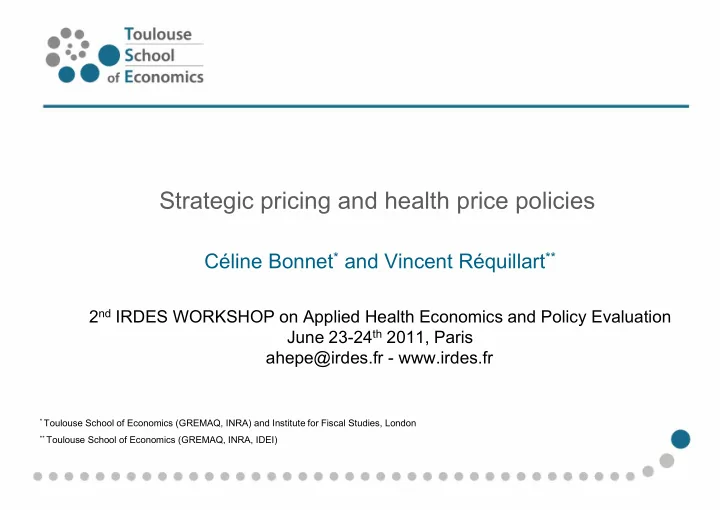

Strategic pricing and health price policies Céline Bonnet * and Vincent Réquillart ** 2 nd IRDES WORKSHOP on Applied Health Economics and Policy Evaluation June 23-24 th 2011, Paris ahepe@irdes.fr - www.irdes.fr * Toulouse School of Economics (GREMAQ, INRA) and Institute for Fiscal Studies, London ** Toulouse School of Economics (GREMAQ, INRA, IDEI)
Context Increase in the obesity prevalence (e.g. 10% in France, 20% in UK and more than 30% in the US). Related diseases. Public policies: mainly information campaigns Eating more healthy foods (Fruits and vegetables, ...) Eating less unhealthy foods (added sugar, fat, ...) Not sufficiently effective Price policies (taxation/subsidies) are not implemented 2
Related Literature: Health Analysis of Price Policies Two stages procedure: demand model and health model Health models: - epidemiological models (Marshall, 2000; Purshouse, Meier, Brennan, Taylor and Rafi, 2010; Dallongeville, Dauchet, de Mouzon, Soler et Requillart, 2010) - obesity (Bonnet , Dubois ad Orozco, 2009; Allais, Bertail and Nichele, 2010; Smith, Lin and Lee, 2010) - health related indicators as diet quality or nutrient content (Jacobson and Brownell, 2000; Chouinard, Davis, LaFrance and Perloff, 2007; Bonnet and Requillart, 2011; Griffith, O’Connell and Nesheim (2010); Smed, Jensen and Denver, 2007; Miao, Beghin, Jensen, 2010) Demand analysis is a key issue 3
Related Literature (cont.): demand analysis General assumption: passive pricing except for Griffith et al (Strategic behavior at the manufacturer level), just consumer reaction Ignoring manufacturer and retailer relationships: drawback as food chain is a chain of oligopolies Imperfect pass-though in the food retailing industry Two main explanations: - markup adjustment of manufacturers and retailers (Bettendorf and Verboven, 2000; Goldberg and Verboven, 2001; Nakamura and Zerom, 2009; Hellerstein and Villas-Boas, 2008; Bonnet, Dubois and Villas Boas, 2009 ) - local non-traded costs (Goldberg and Hellerstein, 2008) Other explanations : Nominal price stickiness and rigidities (fixed costs of repricing); long terms contracts, import quota constraints 4
Objectives To provide a methodology for assessing impacts of price policies taking into account strategic pricing in the agro food industry To check that ignoring strategic pricing involves bad estimations of price policies Test different scenarios of price policies (ad valorem tax and excise tax) 5
Soft Drink Market WHY? Sugar-sweetened beverages could be a contributor to the epidemic of obesity (Harnack et al.,1999; Malik et al., 2006; Schroeter et al., 2008) Sugar is a costly input (7 to 24% of the final price) Substitution between Regular and Diet products Highly concentrated industry at the manufacturer and retail levels Debate on the opportunity to tax (France, EU) Consumption in France 32 l/person/year in average 41 l/person/year for obese people 6
Methodology 4 steps Demand model to assess own and cross price elasticities: Random Coefficients Logit Model as in BLP(95) and Nevo (2000) Supply models, contracts between manufacturers and retailers: linear pricing (Sudhir, 2001; Berto Villas Boas, 2007), Two part tariff contracts with or without Resale Price Maintenance (Bonnet and Dubois, 2010) and where private labels play a role in the vertical relationships or not Selecting the ‘best’ model: cost assumptions and tests (Rivers and Vuong, 2002) Simulating alternative price policies 7
Data French dataset of household purchases on the period 2003-2005; 19,000 households 3 product categories: colas, ice tea, fruit drinks; 2 varieties: regular/diet 11 national brands, 3 private labels, 9 retailers: 105 differentiated products 8
Demand and supply Model: Results Own-price elasticities: -4.1 for all products, -3.9 for regular products, -4.6 for diet products Cross-price elasticities: substitutions between categories (colas, ice tea, fruit drinks) Preferred model: two part tariffs contracts with Resale Price Maintenance where private labels play no role in vertical relationships (due to powerful manufacturers) Price cost margins: 45% (13%) Marginal costs: 0.45€ (0.21), 0.30€ for private labels, 0.50€ for national brands. 9
Impact of taxation Three policies which lead to Ex ante tax revenue neutrality Policy 1: uniform ad valorem tax on regular soft drinks (the VAT of regular products goes up to 19.6% instead of the 5.5%’s) Policy 2: ad valorem tax based on the sugar content of products (a 0.14% tax per gram of sugar per litre is applied VAT from 16.1% to 21.4%) Policy 3: excise tax based on the sugar content of products (0.10 cents of euros per gram of sugar per litre of product tax from 7.4 cents to 11 cents per litre) Results 10
Impact of taxation To sum up the results: • different behavior according to the type of the tax - firms transfer less than the tax when they face to an ad valorem tax (from 60 to 90% of the price increase) - they transfer more in an excise tax case (from 107% to 133% of the excise tax) • brand specific pass-through • prices of diet products change, they gain market shares 11
Impact on household consumption of soft drinks Policy 1 & 2: ad valorem taxes Policy 3: excise tax based on the sugar content • ad valorem tax: ignoring strategic pricing of firms would lead to overestimate the impact on the regular soft drink consumption by 20% and to underestimate by 30% the increase in consumption of diet products • an excise tax: ignoring strategic pricing would lead to underestimate by 15% and 40% the change in consumption of regular and diet products respectively 12
Which tax is the most efficient? • Impact on added sugar consumption: excise tax • Impact on tax revenues: uniform ad valorem tax • Impact on welfare: ad valorem taxes, but 3 similar scenarios for a same added sugar impact 13
Conclusion Our results suggest that: The price transmission of manufacturers and retailers depends on the type of the tax Not taking into account for vertical relationships might lead to badly estimate the impact of policies The excise tax is the most efficient tax to reduce the added sugar consumption (equivalent to a taxation on the sugar input) 14
Recommend
More recommend